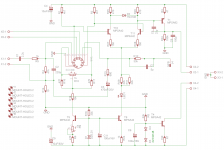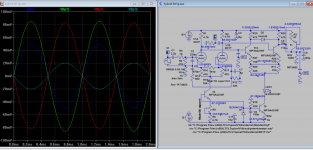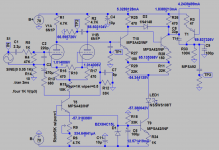Hi Guys,
I built a hybrid IPS that uses the ECC88. It play great but when I tried to use the 6N1P it won't work. I'm attaching the schematic. I'm hoping one of you can give me some ideas of what should be changed so the 6N1P will work. It's operating on +-70V rails.
Thanks, Terry
I built a hybrid IPS that uses the ECC88. It play great but when I tried to use the 6N1P it won't work. I'm attaching the schematic. I'm hoping one of you can give me some ideas of what should be changed so the 6N1P will work. It's operating on +-70V rails.
Thanks, Terry
Attachments
Tube pinout is correct on the schematic so i suspect it is bias problem. Check voltages between legs of R1 and R2, see if they are similar to when ECC88 is in there. With less than 70V between anode and cathode, such low value can mean significant bias difference between ECC88 and 6N1P.
6N1P isn't exactly equivalent to ECC88, a common mistake. ECC88 is closer to 6N23P.
Edit: try adjusting R9 so the voltage dropped on R1 and R2 are similar between 6N1P and ECC88
6N1P isn't exactly equivalent to ECC88, a common mistake. ECC88 is closer to 6N23P.
Edit: try adjusting R9 so the voltage dropped on R1 and R2 are similar between 6N1P and ECC88
Last edited:
Try this: change D1 to 15V zener, R6 to 4.7K. Distortion @TP3 is about 0.5% with NFB grounded. I think should get the plate voltages around +65V to properly bias the coupling transistors by adjust R9, with D1 15V, it's now within range. The sch is for purpose adjustment only.
Attachments
Thanks guys,
Looking forward to trying this. I did try adjusting R6 as-is but couldn't get it there. I will swap the zeners and resistors and report back.
Thanks, Terry
Looking forward to trying this. I did try adjusting R6 as-is but couldn't get it there. I will swap the zeners and resistors and report back.
Thanks, Terry
Try this: change D1 to 15V zener, R6 to 4.7K. Distortion @TP3 is about 0.5% with NFB grounded. I think should get the plate voltages around +65V to properly bias the coupling transistors by adjust R9, with D1 15V, it's now within range. The sch is for purpose adjustment only.
I am planning to make the changes but it occurred to me that I am not clear on how to adjust the bias.I could use some help.
Thanks, Terry
Try this: change D1 to 15V zener, R6 to 4.7K. Distortion @TP3 is about 0.5% with NFB grounded. I think should get the plate voltages around +65V to properly bias the coupling transistors by adjust R9, with D1 15V, it's now within range. The sch is for purpose adjustment only.
Can you share "C:\Program Files (x86)\LTC\LTspiceIV\lib\external\6N1P.inc" file, please?
6N1P is roughly equivalent to ECC85. ECC85 is roughly speaking an ECC81/12AT7 using the ECC88 pinout, so quite different from ECC88.
Can you share "C:\Program Files (x86)\LTC\LTspiceIV\lib\external\6N1P.inc" file, please?
*
* Generic triode model: 6N1P_AN
* Copyright 2003--2008 by Ayumi Nakabayashi, All rights reserved.
* Version 3.10, Generated on Sun Jan 12 18:59:00 2014
* Plate
* | Grid
* | | Cathode
* | | |
.SUBCKT 6N1P A G K
BGG GG 0 V=V(G,K)+-0.42063507
BM1 M1 0 V=(0.007566675*(URAMP(V(A,K))+1e-10))**-0.43818786
BM2 M2 0 V=(0.77391879*(URAMP(V(GG)+URAMP(V(A,K))/29.878541)+1e-10))**1.9381879
BP P 0 V=0.0022884667*(URAMP(V(GG)+URAMP(V(A,K))/38.606817)+1e-10)**1.5
BIK IK 0 V=U(V(GG))*V(P)+(1-U(V(GG)))*0.0013346379*V(M1)*V(M2)
BIG IG 0 V=0.0011442333*URAMP(V(G,K))**1.5*(URAMP(V(G,K))/(URAMP(V(A,K))+URAMP(V(G,K)))*1.2+0.4)
BIAK A K I=URAMP(V(IK,IG)-URAMP(V(IK,IG)-(0.001233721*URAMP(V(A,K))**1.5)))+1e-10*V(A,K)
BIGK G K I=V(IG)
* CAPS
CGA G A 1.6p
CGK G K 3.2p
CAK A K 1.5p
.ENDS
I have built the circuit from post #3. It works but if I adjust R9 so that pin 3 is more than. 8V it gets very noisy. Is this normal? For some reason I thought it should be 1V
Thanks, Terry
Thanks, Terry
I have built the circuit from post #3. It works but if I adjust R9 so that pin 3 is more than. 8V it gets very noisy. Is this normal? For some reason I thought it should be 1V
Thanks, Terry
0.8V or 8V? Should be about 1V. I notice the voltage across 15V zener D1 is about 1.5V less, so maybe R18 should be changed also from 33K to 15K so it's 15V across. See if that is the cause.
Yes, I meant .8V. I'm typing on a tablet and it fights me. At 1v it gets very noisy. I will try changing R18 and get back to you.
Blessings, Terry
Blessings, Terry
6N1P is roughly equivalent to ECC85. ECC85 is roughly speaking an ECC81/12AT7 using the ECC88 pinout, so quite different from ECC88.
I've never worked with a 6N1P, but if it really is roughly equivalent to ECC85 (6AQ8) and ECC81 (12AT7) then a 6N1P won't be happy running with only +65V on its plate. It will be difficult to get enough of a grid bias voltage using cathode bias (i.e., it will be running with nearly 0V grid-cathode).
ECC88 (6DJ8) is a better choice for such a low plate voltage. I'd use 6N23P instead of trying to shoehorn in a 6N1P.
Or maybe not.
--
I've never worked with a 6N1P, but if it really is roughly equivalent to ECC85 (6AQ8) and ECC81 (12AT7) then a 6N1P won't be happy running with only +65V on its plate. It will be difficult to get enough of a grid bias voltage using cathode bias (i.e., it will be running with nearly 0V grid-cathode).
ECC88 (6DJ8) is a better choice for such a low plate voltage. I'd use 6N23P instead of trying to shoehorn in a 6N1P.
Or maybe not.
--
That is good to know. I'm just learning about tubes. The original circuit works very well with the ECC88. The 6N1P is more of an experiment than a necessity. I have actually been testing it at 50v rails so I have probably been sabotaging myself. Thanks for pointing this out.
Blessings, Terry
Yes, you can't normally use high mu valves at low supply voltages. This is because the grid-cathode voltage is too small, so you get significant grid current.
*
* Generic triode model: 6N1P_AN
* Copyright 2003--2008 by Ayumi Nakabayashi, All rights reserved.
* Version 3.10, Generated on Sun Jan 12 18:59:00 2014
* Plate
* | Grid
* | | Cathode
* | | |
.SUBCKT 6N1P A G K
BGG GG 0 V=V(G,K)+-0.42063507
BM1 M1 0 V=(0.007566675*(URAMP(V(A,K))+1e-10))**-0.43818786
BM2 M2 0 V=(0.77391879*(URAMP(V(GG)+URAMP(V(A,K))/29.878541)+1e-10))**1.9381879
BP P 0 V=0.0022884667*(URAMP(V(GG)+URAMP(V(A,K))/38.606817)+1e-10)**1.5
BIK IK 0 V=U(V(GG))*V(P)+(1-U(V(GG)))*0.0013346379*V(M1)*V(M2)
BIG IG 0 V=0.0011442333*URAMP(V(G,K))**1.5*(URAMP(V(G,K))/(URAMP(V(A,K))+URAMP(V(G,K)))*1.2+0.4)
BIAK A K I=URAMP(V(IK,IG)-URAMP(V(IK,IG)-(0.001233721*URAMP(V(A,K))**1.5)))+1e-10*V(A,K)
BIGK G K I=V(IG)
* CAPS
CGA G A 1.6p
CGK G K 3.2p
CAK A K 1.5p
.ENDS
Thank you, very much.
Good day,
I need some help with this exact same circuit please.
I would like to use the 6h30 valve in this circuit.
My supply voltages are + and - 51v dc.
I know the 6h30 only starts to perform at much higher current than used here.
Can anyone suggest some starting values for me to experiment with please?
I would like to run at least 12ma through the tube.
Regards,
Gideon
I need some help with this exact same circuit please.
I would like to use the 6h30 valve in this circuit.
My supply voltages are + and - 51v dc.
I know the 6h30 only starts to perform at much higher current than used here.
Can anyone suggest some starting values for me to experiment with please?
I would like to run at least 12ma through the tube.
Regards,
Gideon
I can raise my supply voltages to + and - 65v dc. They are regulated
Try this. Using 15V zener, tube is biased to about 1V at cathode, transistors bias also slightly altered to suit.
Attachments
Thank you very much.
Can you share your spice model for the 6h30 please?
I don't trust the one I currently have.
Regards,
Gideon
Can you share your spice model for the 6h30 please?
I don't trust the one I currently have.
Regards,
Gideon
Thank you very much.
Can you share your spice model for the 6h30 please?
I don't trust the one I currently have.
Regards,
Gideon
.SUBCKT KTRIODE A G K
+ PARAMS: MU=37.58299 EX=1.132166 KG1=428.9745 KP=402.1368 KVB=321.0256
+ LG=0.2U VBIG=-0.2 EG=1.0389 KG=0.000769 KRG=3.685584 KVG=0.090943
+ CCG=2.4P CGP=3.9P CCP=0.7P CCH=5.6P
E1 7 0 VALUE = {V(A,K) / KP * LOG(1 + EXP(KP * (1/MU + V(G,K) / SQRT(KVB + V(A,K) * V(A,K)))))}
RE1 7 0 1G
G1 A K VALUE = {(PWR(V(7), EX) + PWRS(V(7), EX)) / KG1}
RCP A K 1G ;
C1 G K {CCG} ;
C2 G A {CGP} ;
C3 A K {CCP} ;
C4 K 0 {CCH} ;
E10 10 0 VALUE = {IF(V(A) - V(K) > 0, V(A) - V(K), 0)}
E11 11 0 VALUE = {IF(V(G) - V(K) > VBIG, V(G) - V(K) - VBIG, 0)}
E12 12 0 VALUE = {(KG * (V(11) ** EG) *
+ (((KRG - 1) / (KVG * V(10) + 1)) + 1)) + LG}
G2 G K VALUE = {IF(V(12) > LG, V(12), LG)}
.ENDS
************************************************** *****************
.SUBCKT 6H30 A G K
X1 A G K KTRIODE
+ PARAMS: MU=14.82339 EX=1.386938 KG1=255.6717 KP=99.30537 KVB=1042.421
+ LG=0.2U VBIG=-0.1 EG=1.414474 KG=0.000769 KRG=5 KVG=0.027177
+ CCG=6.3P CGP=6.5P CCP=2.4P CCH=8P
.ENDS
- Status
- Not open for further replies.
- Home
- Amplifiers
- Tubes / Valves
- Converting hybrid from ECC88 to 6N1P



